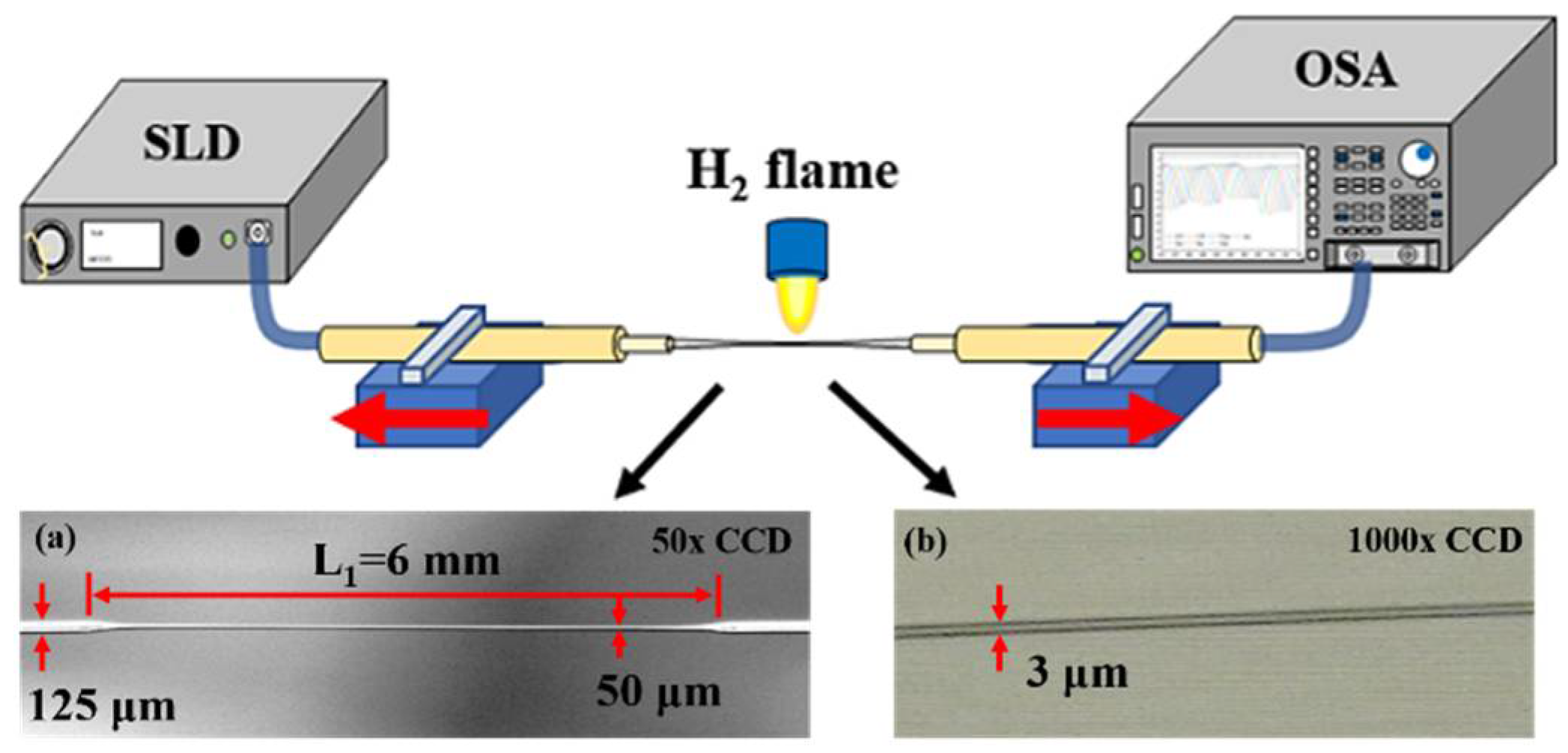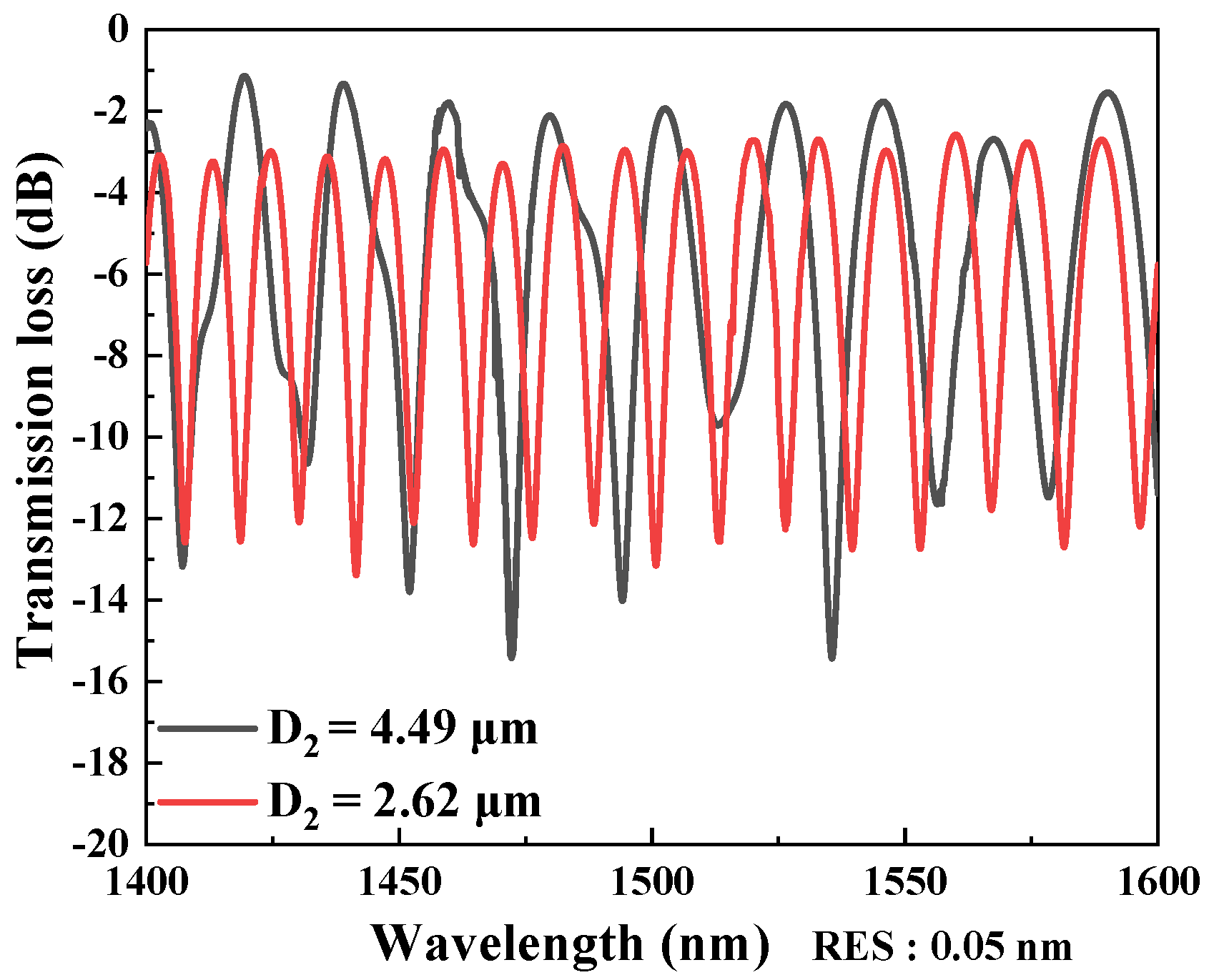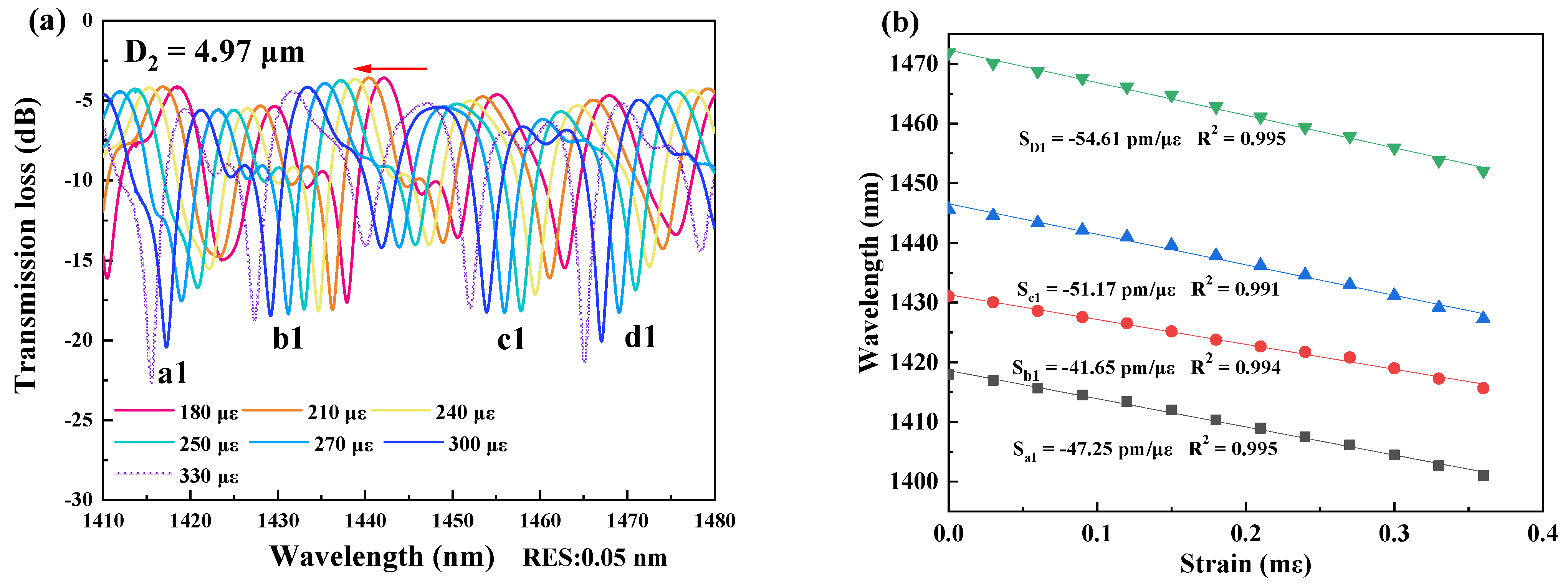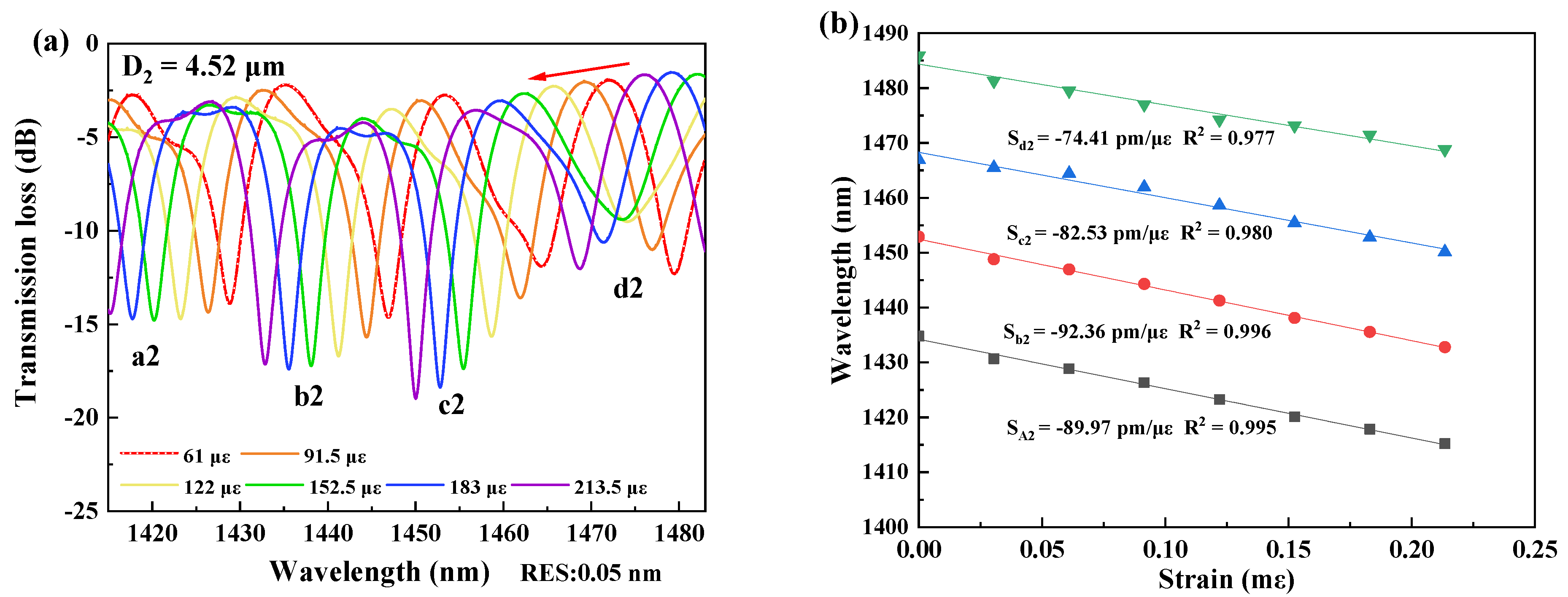High Sensitivity Fiber Interferometric Strain Sensors Based on Elongated Fiber Abrupt Tapers
Abstract
:1. Introduction
2. Experimental Setup
3. Experimental Results and Analysis
4. Conclusions
Author Contributions
Funding
Data Availability Statement
Acknowledgments
Conflicts of Interest
References
- Khan, F.; Donder, A.; Galvan, S.; Galvan, S.; Baena, F.R.; Misra, S. Pose Measurement of Flexible Medical Instruments Using Fiber Bragg Gratings in Multi-Core Fiber. IEEE Sens. J. 2020, 20, 0955–10962. [Google Scholar] [CrossRef]
- Li, Y.; Zhang, X.; Ying, B. On textile biomedical engineering. Sci. China Technol. Sci. 2019, 62, 945–957. [Google Scholar] [CrossRef]
- Tekpinar, M.; Khayatzadeh, R.; Ferhanoglu, O. Multiple-pattern generating piezoelectric fiber scanner toward endoscopic applications. Opt. Eng. 2019, 58, 023101. [Google Scholar] [CrossRef]
- Yadav, T.K.; Narayanaswamy, R.; Bakar, M.H.A.; Kamil, Y.M.; Mahdi, M.A. Single mode tapered fiber-optic interferometer based refractive index sensor and its application to protein sensing. Opt. Express 2014, 22, 22802–22807. [Google Scholar] [CrossRef] [PubMed]
- Ma, R.; Zhang, Z.; Dong, Y.; Pan, Y. Deep Learning Based Vehicle Detection and Classification Methodology Using Strain Sensors under Bridge Deck. Sensors 2020, 20, 5051. [Google Scholar] [CrossRef]
- André, P.; Varum, H.; Antunes, P.; Ferreira, L.; Sousa, M. Monitoring of the concrete curing process using plastic optical fibers. Measurement 2012, 45, 556–560. [Google Scholar] [CrossRef]
- Wang, D.; Zhang, T.; Tao, Y.; Liu, Q. Health monitoring study of bridge expansion joint with new type shock resistance fiber reinforced concrete. Hi-Tech Fiber Appl. 2016, 72–76. Available online: http://en.cnki.com.cn/Article_en/CJFDTOTAL-GKJQ201601012.htm# (accessed on 23 May 2022).
- Liao, W.; Zhuang, Y.; Zeng, C.; Deng, W.; Huang, J.; Ma, H. Fiber Optic Sensors Enabled Monitoring of Thermal Curling of Concrete Pavement Slab: Temperature, Strain and Inclination. Measurement 2020, 165, 108203. [Google Scholar] [CrossRef]
- Liang, F.; Yi, B. Review of Fiber Optic Sensors for Corrosion Monitoring in Reinforced Concrete. Cem. Concr. Compos. 2021, 120, 104029. [Google Scholar] [CrossRef]
- Bao, X.; Chen, L. Recent Progress in Distributed Fiber Optic Sensors. Sensors 2012, 12, 8601–8639. [Google Scholar] [CrossRef] [Green Version]
- Cocking, S.; Alexakis, H.; DeJong, M. Distributed dynamic fibre-optic strain monitoring of the behaviour of a skewed masonry arch railway bridge. JCSHM 2021, 11, 989–1012. [Google Scholar] [CrossRef]
- Kim, D.K.; Kim, J.; Lee, S.-L.; Choi, S.; Jeong, S.J.; Kim, M.S.; Lee, Y.W. Simultaneous Measurement of Strain and Temperature Using Long-Period Fiber Grating Written on Polarization-Maintaining Photonic Crystal Fiber. J. Nanosci. Nanotechnol. 2020, 20, 257–262. [Google Scholar] [CrossRef] [PubMed]
- Kim, D.K.; Lee, S.-L.; Choi, S.; Kim, M.S.; Kim, J.; Han, J.; Lee, Y.W. Bend-Insensitive Simultaneous Measurement of Strain and Temperature based on Cascaded Long-Period Fiber Gratings Inscribed on a Polarization-Maintaining Photonic Crystal Fiber. J. Korean. Phys. Soc. 2020, 76, 810–818. [Google Scholar] [CrossRef]
- Zeng, H.; Geng, T.; Yang, W.; An, M.; Li, J.; Yang, F.; Yuan, L. Combining two types of gratings for simultaneous strain and temperature measurement. IEEE Photon. Technol. Lett. 2016, 28, 477–480. [Google Scholar] [CrossRef]
- Sun, M.; Xu, B.; Dong, X.; Li, Y. Optical fiber strain and temperature sensor based on an in-line Mach–Zehnder interferometer using thin-core fiber. Opt. Commun. 2012, 285, 3721–3725. [Google Scholar] [CrossRef]
- Zhao, Y.; Chen, M.-Q.; Lv, R.-Q.; Xia, F. In-fiber rectangular air fabry-perot strain sensor based on high-precision fiber cutting platform. Opt. Commun. 2017, 384, 107–110. [Google Scholar] [CrossRef]
- Hatta, A.M.; Semenova, Y.; Wu, Q.; Farrell, G. Strain sensor based on a pair of single-mode-multimode single-mode fiber structures in a ratiometric power measurement scheme. Appl. Opt. 2010, 49, 536–541. [Google Scholar] [CrossRef] [PubMed]
- Bakurov, D.; Ivanov, O. Control of Excitation of Cladding Modes by Tapering an Insertion of Special Fiber. Sensors 2021, 21, 2498. [Google Scholar] [CrossRef] [PubMed]
- Herrera-Piad, L.A.; Delgado-Pinar, M.; Cruz, J.L.; Carrascosa, A.; Díez, A.; Rojas-Laguna, R.; Andrés, M.V. Single-mode Bragg gratings in tapered few-mode and multimode fibers. Opt. Lett. 2019, 44, 4024. [Google Scholar] [CrossRef]
- Nguyen, L.V.; Hwang, D.; Moon, S.; Moon, D.S.; Chung, Y. High temperature fiber sensor with high sensitivity based on core diameter mismatch. Opt. Express 2008, 16, 11369–11375. [Google Scholar] [CrossRef]
- Tian, Z.; Yam, S.S.-H. In-Line Abrupt Taper Optical Fiber Mach–Zehnder Interferometric Strain Sensor. IEEE Photon. Technol. Lett. 2009, 21, 161–163. [Google Scholar] [CrossRef]
- Yan, Q.; Liu, W.; Duan, S.; Sun, C.; Zhang, S.; Han, Z.; Jin, X.; Zhao, L.; Geng, T.; Sun, W.; et al. A cascade structure made by two types of gratings for simultaneous measurement of temperature and strain. Opt. Fiber Technol. 2018, 42, 105–108. [Google Scholar] [CrossRef]







| Parameters | Sample1 | Sample2 | Sample3 | Sample4 |
|---|---|---|---|---|
| Tapered diameter D1 | 4.97 μm | 4.52 μm | 4.49 μm | 2.62 μm |
| Clamper distance L2 | 6.7 cm | 6.55 cm | 6.5 cm | 6.55 cm |
| Strain Sensitivity | 48.67 pm/με | 82.84 pm/με | 104.14 pm/με | 116.217 m/με |
| Strain (με) | 0~330 με | 0~213.5 με | 0~246.4 με | 0~213.5 με |
| Coeff. Of determination R2 | 0.994 | 0.987 | 0.998 | 0.999 |
Publisher’s Note: MDPI stays neutral with regard to jurisdictional claims in published maps and institutional affiliations. |
© 2022 by the authors. Licensee MDPI, Basel, Switzerland. This article is an open access article distributed under the terms and conditions of the Creative Commons Attribution (CC BY) license (https://creativecommons.org/licenses/by/4.0/).
Share and Cite
Zhou, H.; Peng, Y.-P.; Chen, N.-K. High Sensitivity Fiber Interferometric Strain Sensors Based on Elongated Fiber Abrupt Tapers. Micromachines 2022, 13, 1015. https://doi.org/10.3390/mi13071015
Zhou H, Peng Y-P, Chen N-K. High Sensitivity Fiber Interferometric Strain Sensors Based on Elongated Fiber Abrupt Tapers. Micromachines. 2022; 13(7):1015. https://doi.org/10.3390/mi13071015
Chicago/Turabian StyleZhou, Haimiao, Ya-Pei Peng, and Nan-Kuang Chen. 2022. "High Sensitivity Fiber Interferometric Strain Sensors Based on Elongated Fiber Abrupt Tapers" Micromachines 13, no. 7: 1015. https://doi.org/10.3390/mi13071015
APA StyleZhou, H., Peng, Y. -P., & Chen, N. -K. (2022). High Sensitivity Fiber Interferometric Strain Sensors Based on Elongated Fiber Abrupt Tapers. Micromachines, 13(7), 1015. https://doi.org/10.3390/mi13071015





